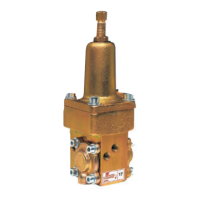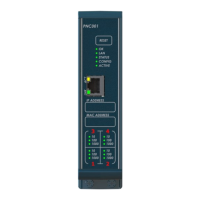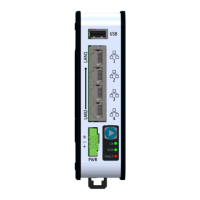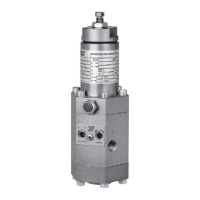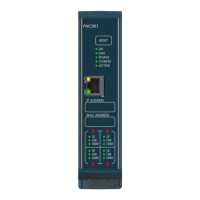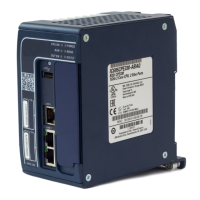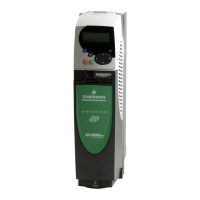Powerdrive F300 Getting Started Guide 95
Issue Number: 5
Safety
information
Product
information
Mechanical
installation
Electrical
installation
Getting started
Basic parameters
(Menu 0)
Running the
motor
Optimization
NV Media Card
Operation
Further
information
UL listing
information
Speed Loop Gains (Pr 00.007 {03.010}, Pr 00.008 {03.011}, Pr 00.009 {03.012})
The speed loop gains control the response of the speed controller to a change in speed demand. The speed
controller includes proportional (Kp) and integral (Ki) feed forward terms, and a differential (Kd) feedback term.
The drive holds two sets of these gains and either set may be selected for use by the speed controller with Pr
03.016. If Pr 03.016 = 0, gains Kp1, Ki1 and Kd1 (Pr 00.007 to Pr 00.009) are used, and if Pr 03.016 = 1, gains
Kp2, Ki2 and Kd2 (Pr 03.013 to Pr 03.015) are used. Pr 03.016 may be changed when the drive is enabled or
disabled. If the load is predominantly a constant inertia and constant torque, the drive can calculate the required
Kp and Ki gains to give a required compliance angle or bandwidth dependant on the setting of Pr 03.017.
NOTE: In sensorless mode, the speed controller bandwidth may need to be limited to 10 Hz or less for
stable operation.
Speed Controller Proportional Gain (Kp), Pr 00.007 {03.010} and Pr 03.013
If the proportional gain has a value and the integral gain is set to zero the controller will only have a proportional
term, and there must be a speed error to produce a torque reference. Therefore as the motor load increases there
will be a difference between the reference and actual speeds. This effect, called regulation, depends on the level
of the proportional gain, the higher the gain the smaller the speed error for a given load. If the proportional gain is
too high either the acoustic noise produced by speed feedback quantization becomes unacceptable, or the
stability limit is reached.
Speed Controller Integral Gain (Ki), Pr 00.008 {03.011} and Pr 03.014
The integral gain is provided to prevent speed regulation. The error is accumulated over a period of time and used
to produce the necessary torque demand without any speed error. Increasing the integral gain reduces the time
taken for the speed to reach the correct level and increases the stiffness of the system, i.e. it reduces the
positional displacement produced by applying a load torque to the motor. Unfortunately increasing the integral
gain also reduces the system damping giving overshoot after a transient. For a given integral gain the damping
can be improved by increasing the proportional gain. A compromise must be reached where the system
response, stiffness and damping are all adequate for the application. For RFC-A Sensorless mode, it is unlikely
that the integral gain can be increased much above 0.50.
Differential Gain (Kd), Pr 00.009 {0 3.012} and Pr 03.015
The differential gain is provided in the feedback of the speed controller to give additional damping. The differential
term is implemented in a way that does not introduce excessive noise normally associated with this type of
function. Increasing the differential term reduces the overshoot produced by under-damping, however, for most
applications the proportional and integral gains alone are sufficient.
There are six methods of tuning the speed loop gains dependant on the setting of Pr 03.017:
1. Pr 03.017 = 0, User set-up.
This involves the connecting of an oscilloscope to analog output 1 to monitor the speed feedback.
Give the drive a step change in speed reference and monitor the response of the drive on the oscilloscope.
The proportional gain (Kp) should be set up initially. The value should be increased up to the point where the
speed overshoots and then reduced slightly. The integral gain (Ki) should then be increased up to the point
where the speed becomes unstable and then reduced slightly.
It may now be possible to increase the proportional gain to a higher value and the process should be
repeated until the system response matches the ideal response as shown.
The diagram shows the effect of incorrect P and I gain settings as well as the ideal response.
Speed demand
Insufficient proportional
gain
[]00.007
Excessive proportional
gain [00.007]
Excessive integral gain
[00.008]
Ideal response
Powerdrive F300 Getting Started Guide English Iss2.book Page 95 Tuesday, July 28, 2015 3:23 PM
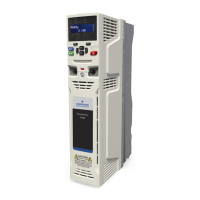
